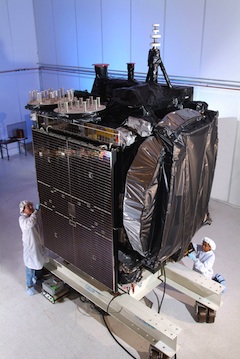E
EarthlingX
Guest
From Roscosmos :
Russia, India, USA and Other Countries Are Concerned with Space Debris Problem
IADC website : Inter-Agency Space Debris Coordination Committee
A couple of interesting documents found there :
IADC Presentation to 47th UNCOPUOS STSC (pdf)
Protection Manual (AI 20.1) rev 3.3 (pdf) ( very informative, different technologies, experiment results, tons of pictures, math and data )
Benefits and Risks of Using Electrodynamic Tethers to De-orbit Spacecraft (AI 19.1) (pdf)
Russia, India, USA and Other Countries Are Concerned with Space Debris Problem
March, 9th , Trivandrum, India. Opening of Inter-Agency Space Debris Coordination Committee (IADC) 28th session.
The main purpose of this organization is to develop the measures to ensure the space flight security in the conditions of technogenic space pollution of near-earth space and to develop the space debris mitigation measures.
ROSCOSMOS has delegated a group of specialists headed by Yuri Makarov to participate the session. Plenary session has been opened with welcoming speech of ISRO leaders and IADC delegations leaders.
IADC website : Inter-Agency Space Debris Coordination Committee
The Inter-Agency Space Debris Coordination Committee (IADC) is an international governmental forum for the worldwide coordination of activities related to the issues of man-made and natural debris in space.
The primary purposes of the IADC are to exchange information on space debris research activities between member space agencies, to facilitate opportunities for cooperation in space debris research, to review the progress of ongoing cooperative activities, and to identify debris mitigation options.
The IADC member agencies include the following:
* ASI (Agenzia Spaziale Italiana)
* BNSC (British National Space Centre)
* CNES (Centre National d'Etudes Spatiales)
* CNSA (China National Space Administration)
* DLR (German Aerospace Center)
* ESA (European Space Agency)
* ISRO (Indian Space Research Organisation)
* JAXA (Japan Aerospace Exploration Agency)
* NASA (National Aeronautics and Space Administration)
* NSAU (National Space Agency of Ukraine)
* ROSCOSMOS (Russian Federal Space Agency)
A couple of interesting documents found there :
IADC Presentation to 47th UNCOPUOS STSC (pdf)
Protection Manual (AI 20.1) rev 3.3 (pdf) ( very informative, different technologies, experiment results, tons of pictures, math and data )
Benefits and Risks of Using Electrodynamic Tethers to De-orbit Spacecraft (AI 19.1) (pdf)








